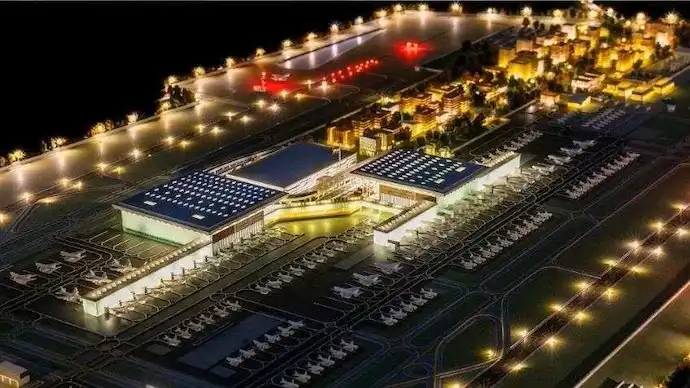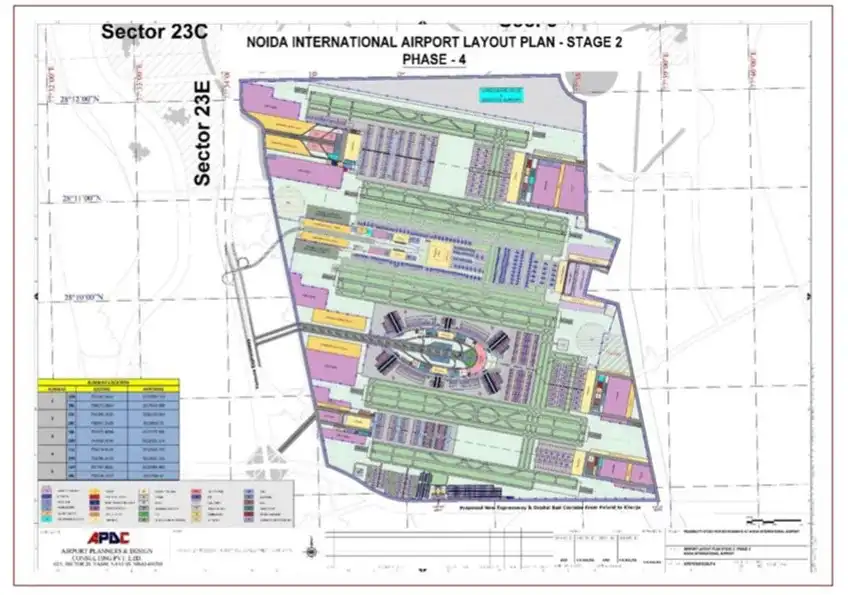Gear Up for Takeoff: Noida International Airport – India’s Aviation Crown Jewel

Highlight: India’s largest airport, the Noida International Airport, is currently under construction in Jewar, Uttar Pradesh. The airport is being developed by Yamuna International Airport Private Limited (YIAPL), a subsidiary of Zurich Airport International AG, in partnership with the Government of Uttar Pradesh and the Government of India.
The Indian aviation sector is on the cusp of a historic transformation. At the forefront of this revolution stands the Noida International Airport, a mega-project destined to become not just India’s largest airport, but also a symbol of the nation’s economic and infrastructural prowess.
A Colossus in the Making
Situated near Jewar in Uttar Pradesh, the Noida International Airport (NIA) is a greenfield project – built from scratch on undeveloped land. This allows for a meticulously designed layout, incorporating the latest advancements in airport technology and passenger comfort.
The initial phase boasts a colossal two-runway configuration, with the potential to expand to a staggering eight runways in the future. This immense capacity positions NIA to become the world’s fourth-largest airport upon completion, effectively dethroning the current leader, Beijing Daxing International Airport.
Beyond Scale: A Hub of Innovation
NIA isn’t just about size; it’s about shaping the future of air travel. The project envisions a seamless passenger experience, integrating cutting-edge technologies like self-service kiosks, automated baggage handling, and smart security systems.
But NIA’s ambitions soar even higher. The airport is being constructed with sustainability as a core principle. Expect eco-friendly practices like rainwater harvesting, solar power generation, and energy-efficient buildings to minimize the environmental footprint.
A Gateway of Opportunity
The Noida International Airport isn’t merely an airport; it’s a catalyst for economic growth. The project is expected to generate a multitude of job opportunities, not just in construction and operation, but also in allied sectors like hospitality, retail, and logistics.
Furthermore, NIA’s strategic location will significantly enhance connectivity for the National Capital Region (NCR), including Delhi, Noida, and surrounding areas. This improved accessibility will undoubtedly attract businesses and investments, further propelling the economic development of the region.

A Glimpse into the Future
The Noida International Airport is much more than concrete and steel. It’s a testament to India’s burgeoning aviation sector and its aspirations to become a global leader in air travel. With its focus on innovation, sustainability, and economic growth, NIA is poised to become a crown jewel in India’s infrastructure landscape.
Project Completion And Beginning of Services
The project is expected to be fully completed by 2040 and will initially handle 12 million passengers annually, eventually expanding to handle 60-120 million passengers annually, making it the largest airport in India and Asia and the fourth largest in the world.
The airport will feature two runways initially and will have a commercial and industrial area of 230 acres, with 75 acres dedicated to commercial use and 155 acres for industrial purposes. The airport is expected to enhance connectivity between Noida, Western Uttar Pradesh, Delhi, and the National Capital Region by easing the traffic load at Indira Gandhi International Airport in Delhi. Additionally, the airport aims to be the country’s first net-zero airport, showcasing Swiss efficiency and Indian hospitality.
The Uttar Pradesh government has allocated Rs 1,150 crore for the airport’s construction and land acquisition under the UP Budget 2024-25. The airport is expected to open for commercial operations by the end of 2024, with the trial run on the runway scheduled to start on June 20, 2024.
The airport will be connected to multiple highways, including the Delhi-Ghaziabad-Meerut Expressway, Ghaziabad-Aligarh-Expressway, and the Delhi-Mumbai Expressway via Faridabad. It will also be connected to the Yamuna Expressway, KGP Expressway, and the Delhi Metro through various routes, enhancing its connectivity to the region.
The airport’s development is expected to have a significant impact on the local economy, with land prices in the area increasing significantly. The airport will also support the growth of industries such as data centers and manufacturing clusters, further boosting the region’s economic prospects.
More details about this project from the official government website here.
More articles on Infrastructure developments here.



